- Home
- Publications et statistiques
- Publications
- Monthly Business Survey – Start of Febru...
The Banque de France publishes a range of monthly and quarterly economic surveys that provide a snapshot of the French economy in the form of business climate indicators and short-term forecasts.
According to the business leaders surveyed (approximately 8,500 companies and establishments questioned between 29 January 2024 and 5 February 2025, before the final adoption of the French government’s budget on 6 February),activity in industry and construction recovered by more than expected last month, and also continued to trend upwards in market services at a higher rate than that expected by businesses. In February, business leaders expect activity to be less buoyant: stable in industry, down slightly in construction and down significantly in market services. Order books are deemed to be weak across all industrial sectors, with the exception of aeronautics. They remain especially depressed in the structural works sector.
Our uncertainty indicator based on comments from companies has increased once again and more sharply in the construction sector.
In particular, the responses mention the uncertain political climate both domestically (economic and fiscal policies) and internationally (fears over higher customs tariffs, especially in the United States).
January is generally a month for reviewing prices. However, the proportion of companies that increased their prices this month was, on the whole, significantly lower than in the last three years, and close to or lower than in the pre-Covid period. Recruitment difficulties continue to abate across all three sectors.
Based on the survey results as well as other indicators, we estimate that activity should increase slightly in the first quarter of 2025, by between 0.1% and 0.2%.
1. In January, activity picked up in industry and construction after declining in December. Market services activity continued to grow
In January, after two flat months, activity trended upwards in virtually all sectors of industry by more than had been forecast by business leaders last month. This upward trend was quite pronounced in the automotive, wearing apparel-textilesfootwear and computer-electronics-optical products sectors. Business leaders in these sectors highlight a catch-up effect from December, when sites closed for longer than usual. The upward trend in pharmaceuticals was confirmed. The agri-food sector continued to grow (orders from outside Europe, due in particular to possible future tensions over customs tariffs). However, metal and metal products contracted for the fourth month in a row. Electrical equipment also declined, albeit to a lesser extent.
CAPACITY UTILISATION RATE
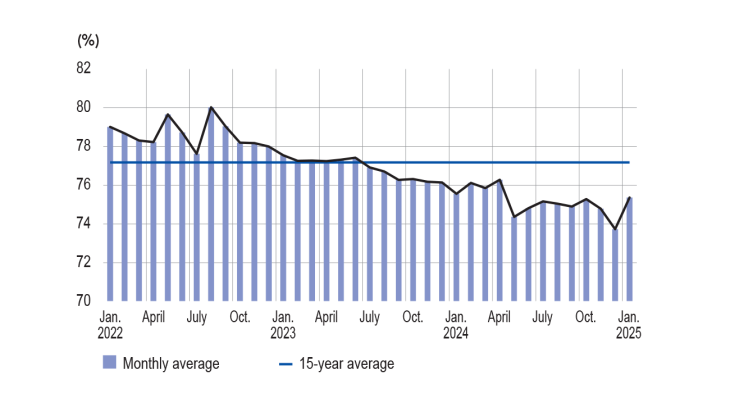
The capacity utilisation rate (CUR) for industry as a whole recovered to 75.4% in January (after a low of 73.7% in December), returning to its October level but still below its long-term average. The indicator rose in most sub-sectors, including wearing apparel-textiles-footwear (up 4 percentage points), automotive products (up 3 percentage points) and computer-electronicsoptical products (up 2 percentage points).
BALANCE OF OPINION ON THE OUTLOOK FOR ACTIVITY (balance of opinion, adjusted for seasonal and working-day variations, forecast for February)
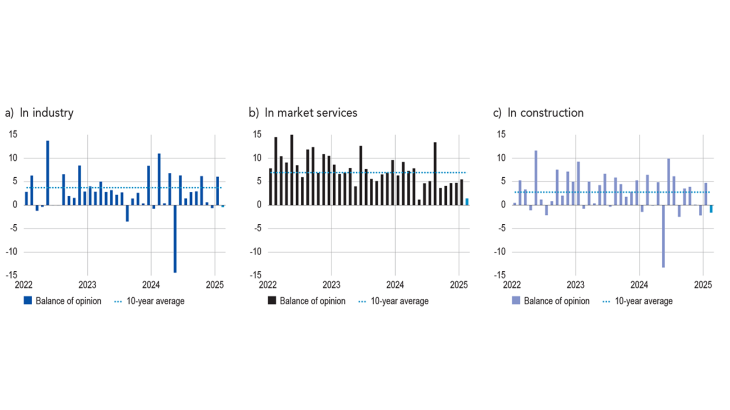
over the past month) stood at 6 percentage points for January in industry. For February (light blue bar), business leaders in industry expect activity to decline by 0.5 percentage points.
Inventories of finished goods decreased slightly compared with December. They fell sharply in the chemicals, electrical equipment and rubber and plastic products sectors, but increased for other industrial products, pharmaceuticals and computer-electronics-optical products. In most sectors, inventories are above their long-term average, with the exception of wearing apparel-textiles-footwear and computerelectronics-optical products.
In market services, activity grew slightly faster than in December and by slightly more than expected by business leaders last month. Activity picked up, especially in information services, and the recovery in cleaning and publishing gathered pace. It continued to grow in the accommodation and food services sector. It was flat in transportation and storage (after December had been boosted by online Christmas shopping deliveries) and the temporary work sector. Programming was the only sector that declined.
INVENTORIES OF FINISHED GOODS IN INDUSTRY (balance of opinion, adjusted for seasonal and working day variations)
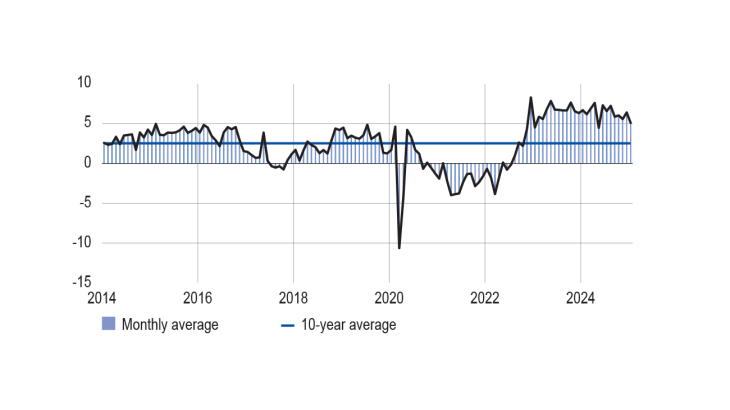
In construction, activity bounced back in January (by more than had been expected the previous month) in both structural and finishing works, after a decline in December, when sites closed for longer than usual.
The balance of opinion on cash positions improved slightly in industry, especially in the pharmaceutical, wood-paperprinting and electrical equipment sectors. However, it was lower in agri-food and declined in the automotive sector. In all sectors, the balance of opinion is below its long-term average.
In market services, the change in the balance of opinion on cash positions was near zero, although there was considerable disparity between sub-sectors. The cash position was deemed satisfactory in the rental, publishing and engineering sectors. However, it was considered weak in transportation and storage, accommodation and food services and vehicle repairs.
CASH POSITION (balance of opinion, adjusted for seasonal and working day variations)
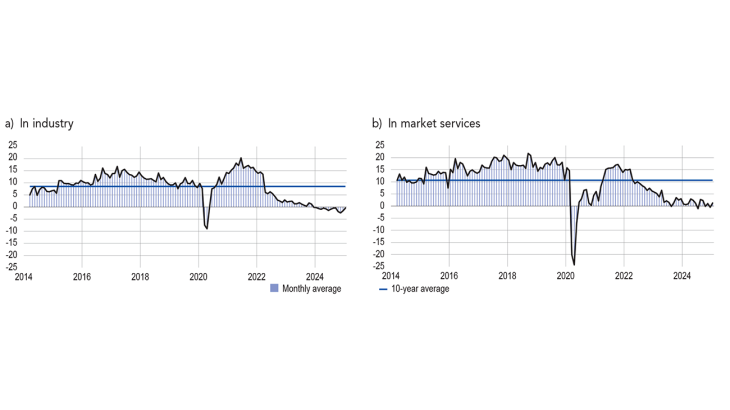
2. In February, business leaders expect activity to change little in industry, to fall slightly in construction and to slow significantly in market services
In February business leaders in industry expect activity to change little, with contrasting trends across sub sectors. It should grow in aeronautics and other industrial products, as well as in computer-electronics-optical products. However, it is expected to decline in chemicals and wood-paper-printing. Activity in metal and metal products should continue to trend downwards, hit by weak demand for cars and foreign competition (especially from China).
In market services, after a buoyant month of January, activity is expected to slow significantly. It should continue to trend upwards in publishing, rental, accommodation and most business services (including engineering, legal and accounting activities, and information services). However, it is expected to decline in leisure activities, personal services and transportation and storage.
Lastly, construction activity is expected to decline once again, dragged down by the structural works sector.
At the end of January, industrial order books remained weak. With the exception of aeronautics, as in previous months, all sectors continued to report weak order books. They were especially low in rubber and plastic products, the automotive industry, machinery and equipment, and metal and metal products. They continue to be deemed well below their long-term average levels in all sectors.
In construction, the assessment of order books remains strongly negative in the structural works sector. Business leaders report that demand is still sluggish, both for the construction of collective housing, standalone housing and public projects. Certain construction companies have begun specialising in finishing work, including energy renovation work, which remains the most buoyant construction segment.
Our monthly uncertainty indicator, which is constructed from a textual analysis of comments by surveyed companies, rose in all three sectors. This was especially the case in the construction sector, where it rose to its highest level since March 2022. Business leaders mainly highlighted the domestic political climate as a factor ouncertainty, particularly with regard to fiscal and tax policy. Business leaders in industry also refer to international trade tensions.
LEVEL OF ORDER BOOKS (balance of opinion, adjusted for seasonal and working day variations)
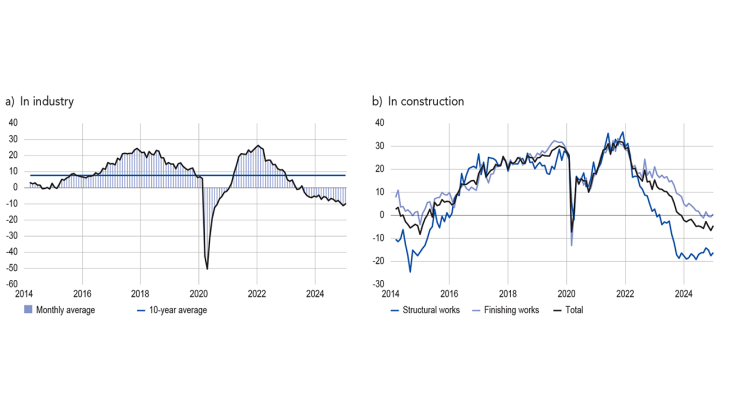
UNCERTAINTY INDICATOR IN THE COMMENTS SECTION OF THE MONTHLY BUSINESS SURVEY (MBS)
(unadjusted data)
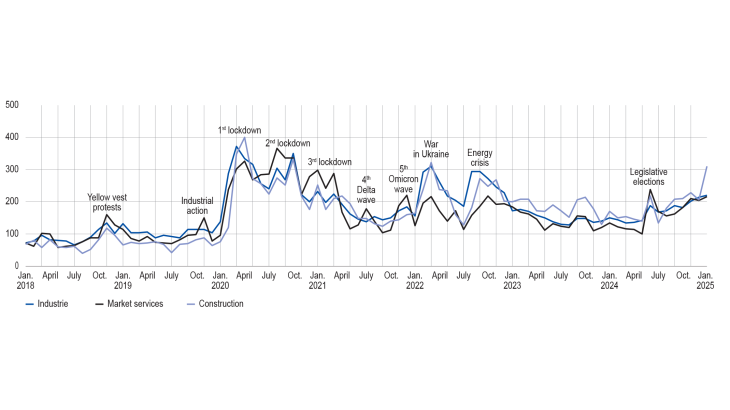
3. Price increases at the start of the year were less widespread than in previous years
In January, supply difficulties in industry were generally stable month on month at a relatively low level (9% of companies reported them, down 1 percentage point on December). For transport equipment – the sector most affected – supply difficulties are easing in the automotive sector (9%), but remain relatively high in the aeronautical sector (28%). They increased in computer-electronics-optical products (15%) and machinery and equipment (13%) but remained rare in the construction sector (2%).
In industry, business leaders reported that raw material prices have fallen slightly. They fell significantly in the automotive, wearing apparel-textiles-footwear and computer-electronicsoptical products sectors. The balance of opinion on finished goods prices1 was slightly positive and stable compared with December, with contrasting trends between sub-sectors: a downward trend in machinery and equipment and chemicals, and an upward trend in agri-food and pharmaceuticals prices.
January is generally a month for reviewing prices. However January 2025 was characterised by less widespread price increases than at the beginning of previous years. More specifically, 13% of business leaders in industry reported that they had raised their selling prices in January, a lower proportion than in January 2022-24, and lower even than in the pre-Covid period. Price increases were slightly more common in pharmaceuticals (24%) and apparel-textiles-footwear (20%). Conversely, 5% of business leaders in industry reported having cut their selling prices, a higher proportion than in the month of January before Covid. Decreases in finished goods prices were mainly concentrated in chemicals (14%) and wood-paper-printing (9%).
In construction, as in December, the balance of opinion on selling prices remains negative, dragged down by the structural works sector. 10% of business leaders reported increasing their quote prices, which was less than the level observed in January of previous years. An equivalent proportion of business leaders, i.e. 10%, said they had reduced their quote prices, a higher proportion than in January in previous years.
In services, the balance of opinion on selling prices improved but remained comparable to pre-Covid levels. The proportion of companies reporting an increase in prices was 22%, well below the month of January for the last three years, but slightly higher than pre-Covid January figures. At the same time, the proportion of companies reporting a drop in their prices was 4%, on a par with figures reported in January of previous years. Price rises mainly concerned cleaning, leisure activities and personal services (reflecting the increase in the minimum wage in November), as well as legal and accounting services.
In February, 9% of industrial firms plan to raise their prices (versus 13% in February 2024). In market services and construction, the proportions are 12% and 5%, respectively(compared with 12% and 10% in February 2024).
In January, 26% of business leaders reported recruitment difficulties, 4 percentage points lower than in December.
More specifically, the proportion declined this month in the market services sector.
CHANGE IN FINISHED GOODS PRICES BY MAJOR SECTOR
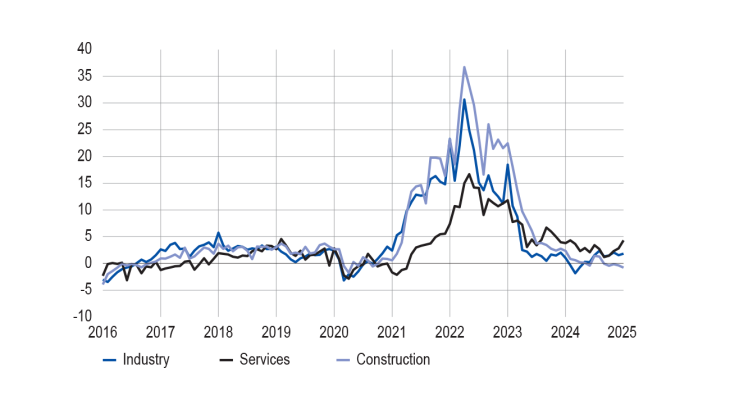
SHARE OF BUSINESSES REPORTING RECRUITMENT DIFFICULTIES (%, unadjusted data)
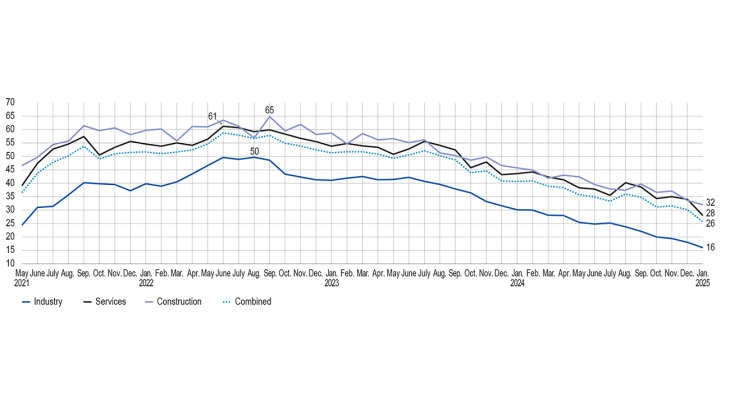
4. Our estimates suggest that GDP will edge up slightly in the first quarter, by between 0.1% and 0.2%
The quarterly account first estimates published by INSEE at the end of January reported a 0.1% drop in GDP growth in the fourth quarter of 2024, partly due to the negative counter effects of the Olympic and Paralympic Games, which had boosted growth in the third quarter. Value added declined in agriculture, manufacturing, construction and market services (taking into account the negative, one-off counter effects of the Olympic and Paralympic Games), but it rose in non-market services and energy. The change in activity was slightly below what we had forecast in our last update on business conditions, especially in manufacturing.
Based on the results of the Banque de France monthly business survey, rounded out by other available data (INSEE production indices and surveys and high-frequency data), we estimate that GDP should increase slightly in the first quarter, by between 0.1% and 0.2%. Value added in market services is expected to recover in the wake of the one-off drop reported in the previous quarter, and should increase once again in the energy sector. Value added in manufacturing is expected to remain stable, reflecting a negative carry-over effect from the industrial production index in December, offsetting the positive monthly business survey balances in January. Lastly, construction is expected to decline once again, but less sharply than in the previous quarter.
QUARTERLY CHANGES IN GDP AND VALUE ADDED IN FRANCE (%)
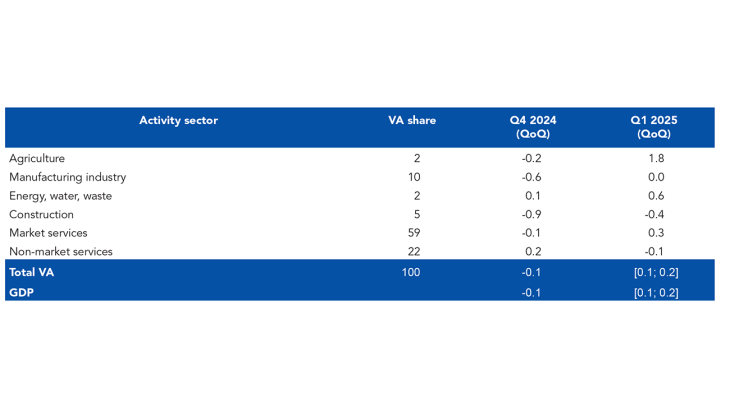
Note: QoQ = quarterly change.
Download the full publication
Updated on the 19th of February 2025